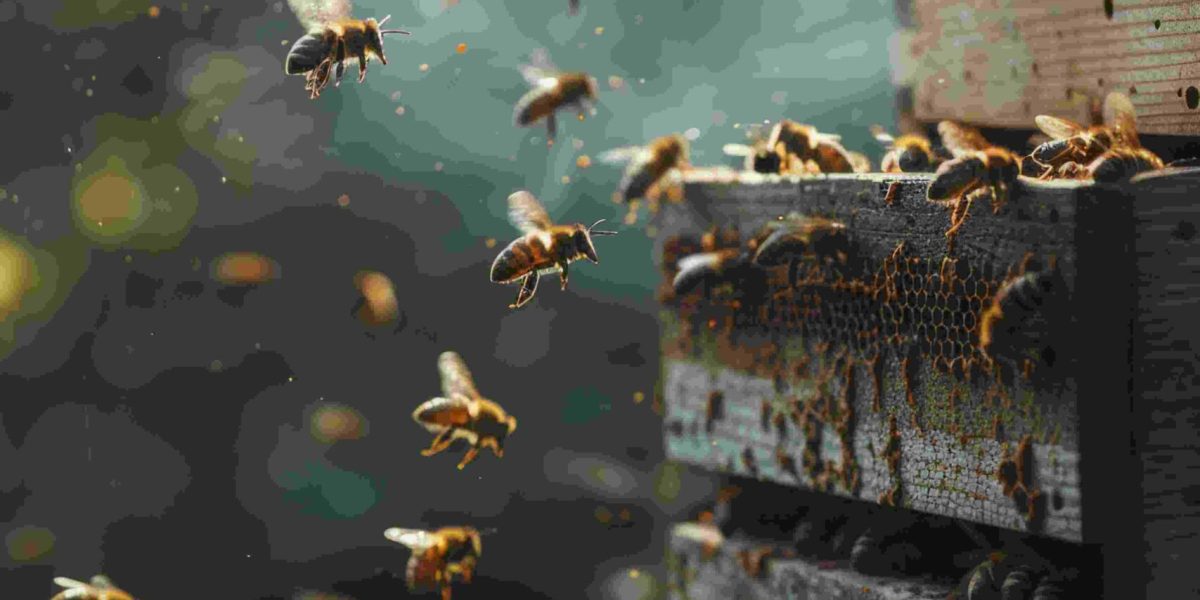Introduction
The world of modern beekeeping has evolved beyond traditional practices. Today, with the integration of smart technologies, beekeepers can remotely monitor hive health, temperature, humidity, and more. A Beehive Monitoring System is no longer a futuristic concept but a modern necessity supporting hive maintenance and bee welfare. Alongside this, one persistent challenge that beekeepers face is ant infestation, which can harm both the hive and the honey production cycle. In this blog, we’ll explore effective tips to keep ants out of the beehive, present an ecumenical sketch of differential beehives, and offer an in-depth look at the hidden, uncharted world of bees.
1. The Importance of a Beehive Monitoring System
A Beehive Monitoring System uses IoT (Internet of Things) technology, smart sensors, and cloud computing to help beekeepers track vital hive parameters. These include:
- Temperature and Humidity: Ensuring an ideal brood-rearing environment.
- Weight Monitoring: Tracking honey production and consumption.
- Sound Frequency Monitoring: Detecting changes in colony behavior or swarming.
- Intrusion Alerts: Notifying beekeepers of animal or human interference.
- Remote Access: Access data from any location using mobile or web applications.
Benefits for Beekeepers:
- Reduced manual inspection
- Early detection of health problems
- Increased productivity
- Data-driven hive management
- Real-time insights into queen failure or hive abandonment
With climate change and rising threats to bee populations, these systems are indispensable in both commercial beekeeping and sustainable beekeeping practices. Beehive monitoring devices can also integrate weather forecasts and suggest best times for hive interventions, reducing human stress on colonies.
Key Features to Look for:
- Solar-powered or battery-operated devices
- Bluetooth and Wi-Fi enabled options
- Mobile alerts with AI insights
- Waterproof, rugged design
- Modular and scalable architecture
Embracing these features helps beekeepers adopt more eco-friendly and efficient operations.
2. Effective Tips to Keep Ants Out of the Beehive
Ant infestation in beehives is more than just an inconvenience; they are resource thieves. They steal honey, stress out bees, and can lead to hive abandonment. Here are some proven and effective tips to keep ants away from your beehive:
1. Apply a Moat Barrier
- Use a water-filled tray under the hive legs. Ants can’t swim and will be unable to cross.
- Add a few drops of soap or oil to the water to ensure surface tension is broken.
2. Use Natural Repellents
- Sprinkle cinnamon, vinegar, lemon juice, or diatomaceous earth around the hive base.
- Essential oils such as peppermint and tea tree can be added to cotton balls placed near hive legs.
3. Grease the Hive Stand
- Apply sticky substances like petroleum jelly or Tanglefoot on hive legs.
- Reapply after rain or every two weeks to maintain effectiveness.
4. Keep the Hive Area Clean
- Remove dead bees and spilled honey.
- Avoid placing food or syrup containers near hives.
- Use trash-proof fencing if your apiary is near populated areas.
5. Elevate the Hive
- Position hives on stands with ant-proof barriers.
- Consider placing the hive over a concrete or tile surface to reduce ant hiding spots.
6. Control Surrounding Vegetation
- Trim grasses and remove climbing plants. This stops ants from using them as bridges.
- Use weed cloth to prevent regrowth.
7. Use Ant Deterrent Traps
- Commercial ant baits placed far from the hive can help reduce local ant populations.
- Boric acid and sugar water traps work well in controlled use.
8. Inspect Regularly
- Routine checks help catch infestations early.
- Track and trail back to colonies and eliminate nests where possible.
Implementing these effective tips to keep ants out of the beehive will lead to healthier, more productive hives and reduce colony stress during nectar flow seasons.
3. Ecumenical Generic Sketch of Differential Beehives
Understanding the different types of beehives used globally helps in selecting the right model based on climate, bee species, and productivity goals. Here’s an ecumenical generic sketch of differential beehives:
Langstroth Hive (USA)
- Most popular design globally
- Stackable rectangular boxes with frames
- Enables high honey yields
- Preferred for commercial apiaries and migratory beekeeping
Top-Bar Hive (Africa, Caribbean, Urban Gardens)
- Single horizontal box with removable bars
- Bees build comb freely
- Promotes natural colony structure
- Ideal for educational settings and beginners
Warre Hive (France)
- Vertical box hive mimicking wild tree cavities
- Uses top-bars like the top-bar hive
- Focused on bee welfare over honey harvest
- Adds boxes from below, respecting bee instincts
Flow Hive (Australia)
- A modern adaptation of Langstroth
- Plastic frames allow honey extraction without opening hive
- Suitable for backyard beekeepers and small-scale urban farms
- Criticized for high costs and plastic use but praised for ease
Log Hive (Traditional – Asia, Africa, Eastern Europe)
- Carved or hollowed-out logs
- Minimal maintenance
- Used by traditional or indigenous communities
- Poor honey yield but excellent for pollination support
Each design plays a unique role in modern beekeeping, catering to regional climates, local flora, and beekeeper preferences. Selecting the right hive type can reduce stress for bees and enhance colony longevity.
Key Factors When Choosing a Hive:
- Bee species (Apis mellifera vs. Apis cerana)
- Climate and elevation
- Access to tools and materials
- Objective: Honey production, pollination, conservation, or education
4. In-Depth Information of the Uncharted Bees’ World
The In-Depth information of the uncharted bees world is as intricate as any human society. These pollinators are a cornerstone of Earth’s ecosystems, influencing agriculture, biodiversity, and climate resilience.
Social Structure and Roles
- Queen Bee: Mother of all bees in the colony. Lives 3–5 years. Controlled by pheromones.
- Worker Bees: All-female, sterile bees. Handle foraging, hive care, nursing, guarding, and cleaning.
- Drone Bees: Males. Their sole role is mating with queens during nuptial flights.
Language of Bees
- Waggle Dance: Communicates food source direction and distance.
- Vibrational Signals: Used during swarming, queen replacement.
- Scent Trails: Help return to hive or lead others to new nest locations.
Pollination and Food Security
- Bees pollinate 1/3 of global crops.
- Vital for almonds, apples, blueberries, cucumbers, and melons.
- Estimated $235–577 billion in global crop value is attributable to bee pollination.
Navigational Marvels
- Bees use sun position, magnetic fields, and polarized light to orient themselves.
- Can recognize complex patterns, shapes, and even human faces.
Threats to Bee Survival
- Pesticide Exposure: Neonicotinoids linked to Colony Collapse Disorder.
- Parasites and Diseases: Varroa mites, Nosema, American Foulbrood.
- Climate Change: Alters flowering seasons, disrupts nectar availability.
- Habitat Loss: Urban expansion, monoculture farming.
Bees in Mythology and Culture
- Considered sacred in many cultures (Egyptians, Mayans, Hindus).
- Symbolize diligence, immortality, community.
- Featured in medieval alchemy and modern corporate metaphors.
Learning about the in-depth, uncharted world of bees not only enhances your respect for these tiny engineers but also encourages sustainable co-existence.
5. Role of IoT in the Future of Beekeeping
The adoption of IoT-based Beehive Monitoring Systems is paving the way for precision apiculture where data, automation, and AI guide decisions.
How IoT Transforms Beekeeping:
- Real-Time Alerts: Notifies beekeepers of temperature spikes, predator intrusions, or honey theft.
- Cloud-Connected Dashboards: Visualize long-term trends in hive performance.
- AI Predictions: Anticipate swarming, colony decline, or queen loss.
- Remote Decision-Making: Reduce fuel usage and human interaction.
- Integration with Weather APIs: Suggest ideal harvest or inspection times.
Environmental Benefits:
- Reduced carbon footprint through fewer in-person checks
- Higher survival rates during harsh winters or droughts
- Better disease management with early detection
Global Movement Toward Smart Beekeeping:
- Projects in the EU and India are promoting Smart Hive initiatives.
- Startups now offer subscription-based hive analytics services.
With these advancements, Beehive Monitoring Systems become the cornerstone of a bee-centric, data-driven future.
Smart Sensors in Beehive Monitoring: What’s Inside the Hive?
Modern beehive monitoring systems rely heavily on smart sensors that provide real-time insights. Here are the key types of sensors used and what they measure:
Types of Sensors
- Temperature Sensors
- Keep track of brood temperature (ideal range: 32°C–35°C).
- Fluctuations may indicate brood disease, queenlessness, or absconding.
- Humidity Sensors
- Monitor internal hive humidity.
- Helps prevent mold and supports brood development.
- Weight Sensors
- Installed under the hive.
- Track honey production and population growth.
- Microphones / Acoustic Sensors
- Record bee buzzing patterns.
- Help detect swarming behavior, queen loss, or hive stress.
- GPS Trackers
- Used in mobile hives or during relocation.
- Prevent theft and track hive movement.
- CO₂ & Air Quality Sensors
- Track respiratory activity.
- Alert beekeepers to overcrowding or poor ventilation.
These sensors sync with cloud platforms or mobile apps, allowing beekeepers to monitor multiple hives across locations with ease.
How to Install and Maintain a Beehive Monitoring System
Setting up a smart beehive system may sound technical, but it’s manageable even for small-scale beekeepers.
Installation Guide
- Choose the Right System
- Popular brands: BroodMinder, Arnia, BeeSecure, HiveWatch.
- Compare based on sensor range, mobile compatibility, and pricing.
- Install the Sensors
- Temperature/humidity: inside or under the brood box.
- Weight scale: place under the hive base.
- Microphone: inside the hive lid or beneath the brood chamber.
- Connect to the Network
- Sync the sensors to Wi-Fi or a mobile network.
- Install the associated app on your smartphone or tablet.
- Start Monitoring
- Set alerts for temperature drops, weight changes, or abnormal sounds.
- Use collected data to adjust feeding, treatment, or hive maintenance.
Maintenance Tips
- Check Battery Levels: Replace or recharge batteries regularly.
- Clean Sensors: Wipe down gently during hive inspections.
- Firmware Updates: Keep the system up-to-date for accuracy and security.
- Test Alerts: Ensure that push notifications are working and calibrated properly.
The Future of Beekeeping: AI, Robotics, and Automation
As global awareness of bee conservation grows, beekeeping is entering a new era driven by automation and artificial intelligence.
AI-Driven Hive Management
- Predictive Analytics: AI models use historical data to forecast swarming, disease outbreaks, or nectar flows.
- Health Diagnosis: Algorithms analyze audio or visual input to detect problems like Varroa mites or queen failure.
- Behavioral Analysis: AI tracks bee movement patterns to detect unusual behavior before colony collapse.
Robotic Assistants
- Automated Inspections: Robotic arms with cameras can inspect hives without opening them.
- Smart Dispensers: Deliver sugar syrup, water, or medication based on hive needs.
- Drones: Used for environmental surveys, tracking foraging areas, or spraying organic mite treatments.
Blockchain & Data Sharing
- Beekeepers can now share data globally through secure platforms, contributing to research and collaboration across borders.
- Traceability ensures pure honey sourcing, building consumer trust and promoting sustainable practices.
Conclusion
Modern beekeeping is a blend of science, ecology, and care. The Beehive Monitoring System is an essential asset in ensuring hive health, improving productivity, and adapting to environmental changes. With the constant threat of ants, knowing effective prevention methods helps protect your colonies. From an ecumenical view of differential hives to understanding the uncharted world of bees, this field offers endless learning and discovery.












